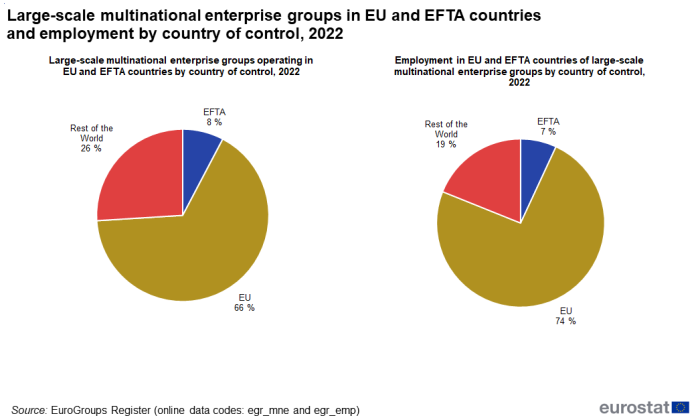Employment in large-scale multinational enterprise groups
Data extracted in April 2024
Planned article update: 30 April 2025
Highlights
In 2022, more than 32 million people were working in large-scale multinational enterprise groups operating in the EU and EFTA countries, according to the EuroGroups Register.
This article gives an overview of the employment and control of the large-scale multinational enterprise groups operating in the EU and European Free Trade Association (EFTA) countries (EU-EFTA) in 2022, according to the data available in the European statistical register on multinational enterprise groups (EuroGroups Register (EGR)). A large-scale multinational enterprise group is a multinational enterprise group employing more than 1 000 people in EU and EFTA countries and having more than 150 people employed in at least two EU and EFTA countries.[1]
In 2022, according to the EGR:
- About 32 million people were working in large-scale multinational enterprise groups operating in EU and EFTA countries; these represent an increase of around 2 million people with respect to the previous year. From the total workforce of multinational enterprise groups operating in the EU-EFTA territory, 2 out of 3 of them were working in a large-scale one.
- The vast majority of the people employed in large-scale multinational enterprise groups (74 %) were working in a group controlled by an EU or EFTA country.
- Most of these groups (almost half) were active mainly in the manufacturing sector, and concentrated 35 % of the people employed in them.
Check the structure of multinational enterprise groups in the EU for more information about the entire population of multinational groups in the EU and EFTA countries in EGR.
Full article
Employment in large-scale multinational enterprise groups operating in the EU and EFTA countries
The source used in this article is the EGR, the European statistical business register for multinational enterprise groups. A multinational enterprise group is an enterprise group that operates in at least two countries, with one of these being in the EU or EFTA. Among them, large-scale multinational enterprise groups are the groups employing at least 1 000 people in the EU and EFTA countries and having at least 150 people employed in each of two of these countries. These groups are important for those Directorates General of the European Commission having responsibilities on the implementation of policy in the employment area.
In 2022, according to the EGR:
- Among the 47 million people working in a multinational enterprise group in EU and EFTA countries, 32 million of them were working in a large-scale multinational enterprise group. This represents an increase of around 2 million people with respect to the previous year.
- Around 3 900 (almost 100 more than the previous year) large-scale multinational groups were present in the EU and EFTA countries, accounting for 2 % of the multinational enterprise groups operating in EU-EFTA.
Which countries control the large-scale multinational enterprise groups that operate in the EU and EFTA countries?
Most of the large-scale multinational enterprise groups that operate in the EU and EFTA countries are controlled from a country within the EU-EFTA territory (3 out of 4). However, within the EU-EFTA as well as from outside, few countries control most of these large-scale multinational enterprise groups:
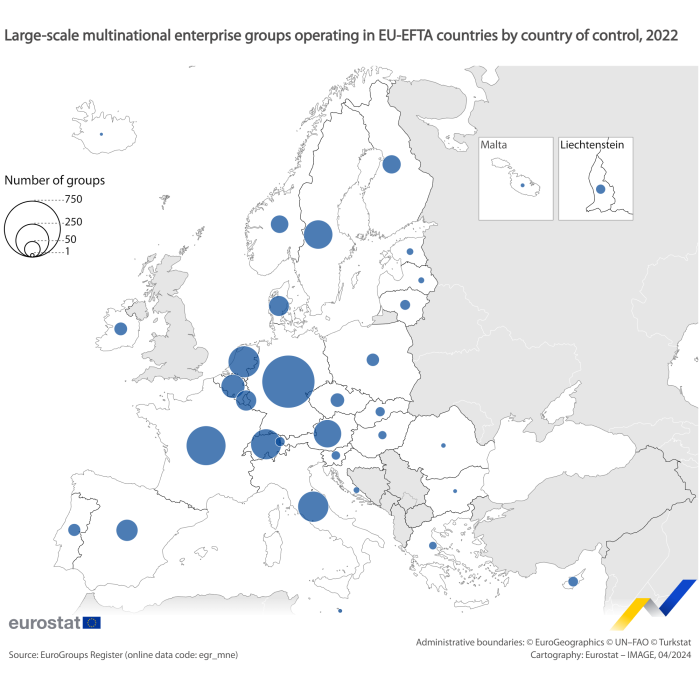
Source: EuroGroups Register (egr_mne)
Within the EU territory, most groups are controlled by Germany, with more than 650 of them; followed by France, the Netherlands and Italy, controlling more than 200 groups each. In the EFTA territory, the country controlling the most groups is Switzerland, also with more than 200 groups. There are some small countries which control a large number of groups given their size, this is the case, for example, of Luxembourg, controlling almost 100 groups.
From outside the EU-EFTA territory, the countries controlling large-scale multinational enterprise groups operating in the EU-EFTA economy are the United States and the United Kingdom, followed by Japan:
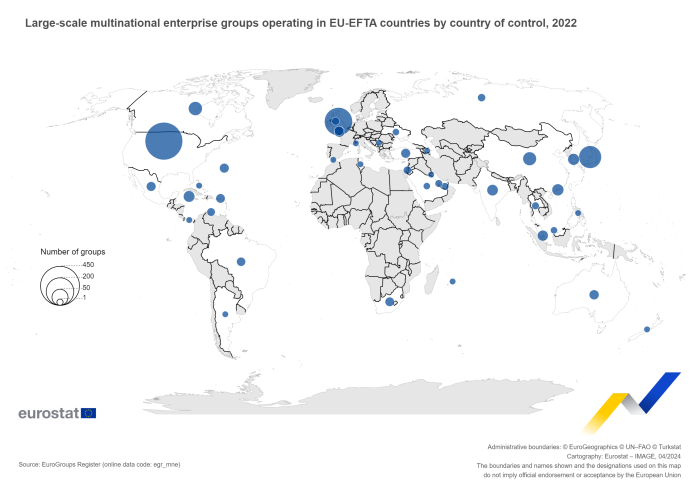
Source: EuroGroups Register (egr_mne)
How much large-scale multinational enterprise groups impact the national employment?
Workers of large-scale multinational enterprise groups are spread across the different EU and EFTA countries. According to structural business statistics (SBS), around 165 million people were working in the EU-EFTA territory; out of those, almost 20 % (32 million) of them worked in a large-scale multinational enterprise group.
However, the distribution of these workers is heterogeneous across the different countries:
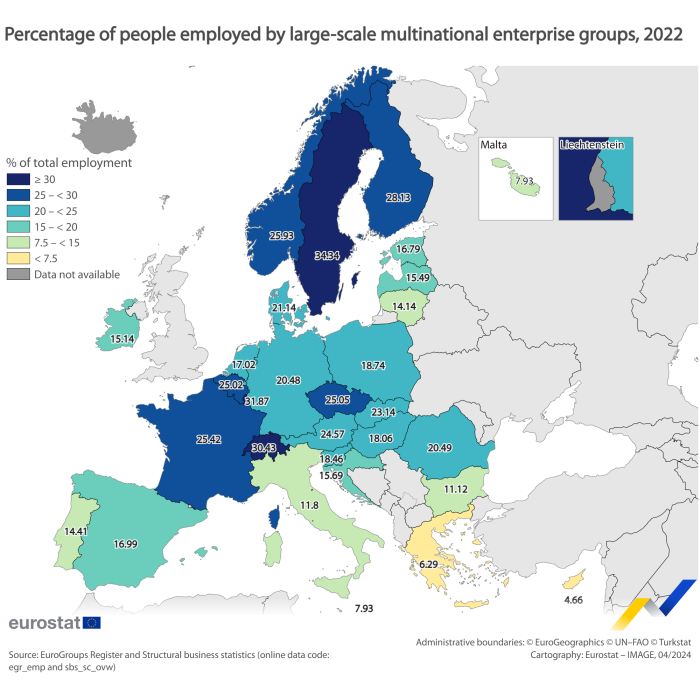
Source: EuroGroups Register (egr_emp) and (sbs_sc_ovw)
In Cyprus and Greece the impact of large-scale multinational enterprise groups in the national employment was limited, with less than 7.5 % of the workforce being employed at a large-scale multinational enterprise group. On the contrary, in other countries, such as Luxembourg, Sweden, or Switzerland more than 20 % of the workforce is being employed by at a large-scale multinational enterprise group.
In which sectors do large-scale multinational enterprise groups operate?
In 2022, the EGR large-scale multinational enterprise groups operating in the EU and EFTA countries carried out a large variety of economic activities, covering almost 20 NACE sections and around 80 NACE divisions. These groups were mainly active in the manufacturing sector, covering 48 % of them. However, in terms of employment, although the manufacturing sector is still the most prevalent, it accounts for a lower share, with 35 % of the employment in large-scale multinational enterprise groups. This indicates that groups operating mainly in the manufacturing sector tend to be smaller in terms of employment when compared to other sector groups active in other sectors, like it can be, for instance, the financial or insurance services:
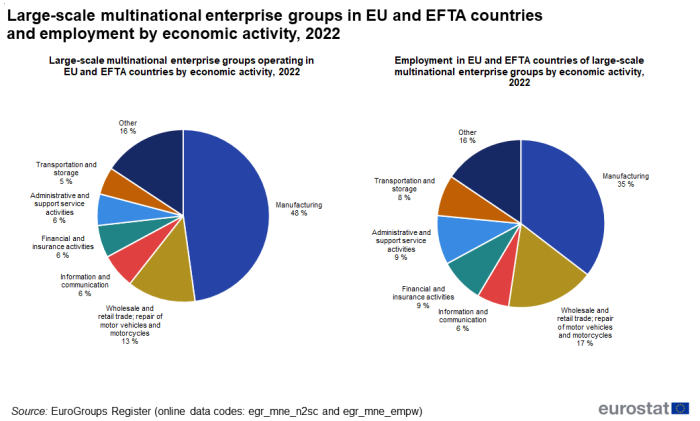
Source: EuroGroups Register (egr_mne_n2sc) and (egr_mne_empw)
Feedback
To help Eurostat improve these experimental statistics, users and researchers are kindly invited to give us their feedback by email
Data sources
The EGR database is the source of the above-mentioned large-scale MNE groups data. The EGR is the statistical business register of the EU Member States and EFTA countries for MNE groups. It produces data in yearly cycles and covers microdata on the groups and their enterprises and legal units.
The EGR aims to register all MNE groups that have enterprises in EU Member States or EFTA countries, including European and non-European groups. The EGR does not cover all-resident enterprise groups – those with enterprises only in one country, and independent enterprises.
The EGR microdata help explore the structure and impact of MNE groups in Europe. We can analyse group size, complexity, and employment patterns in European countries, together with their European influence.
The EGR makes it possible to present results from two sides: from the MNE group perspective, based on the country of control of the group, and from the national perspective of the country in which the group is located, irrespective of where the control unit is located.
The EGR is a statistical business register that serves statistical purposes only. Access to EGR data is restricted to national statistical institutes and national central banks that produce official statistics in the EU Member States and EFTA countries.
Context
Globalisation and the increasing complexity of multinational enterprise group activities means it is difficult to produce business statistics and macroeconomic statistics and correctly and consistently reflect MNE group activities in European statistics. To better analyse cross-border transactions of large-scale multinational enterprise groups and correctly record them in statistical business registers, statisticians in the European Statistical System (ESS) and European System of Central Banks (ESCB) need to be able to observe the complete and correct economic structures of MNE groups.
Direct access to
- Multinational enterprise groups methodological note
- Methodology on enterprise groups and registers is available in the Business registers Recommendations manual
- EuroGroups Register metadata EGR 2020 Metadata Report
- Regulation (EEC) No 696/1993 of 15 March 1993 on the statistical units for the observation and analysis of the production system in the Community (Summary)
- Directive 2009/38/EC of the European Parliament and of the Council of 6 May 2009 on the establishment of a European Works Council or a procedure in Community-scale undertakings and Community-scale groups of undertakings for the purposes of informing and consulting employees (Recast) (Text with EEA relevance)
- Regulation (EU) 2019/2152 of the European Parliament and of the Council of 27 November 2019 on European business statistics, repealing 10 legal acts in the field of business statistics
- Implementing Regulation (EU) 2020/1197 of 30 July 2020 laying down technical specifications and arrangements pursuant to Regulation (EU) 2019/2152 of the European Parliament and of the Council on European business statistics repealing 10 legal acts in the field of business statistics
Notes
- ↑ The definition of a large-scale multinational enterprise group is motivated by the consultation review of Directive 2009/38/EC.
